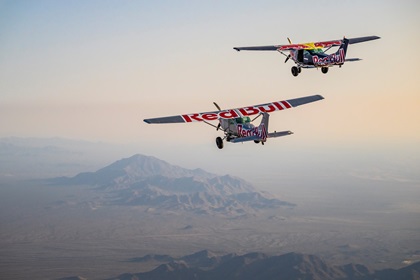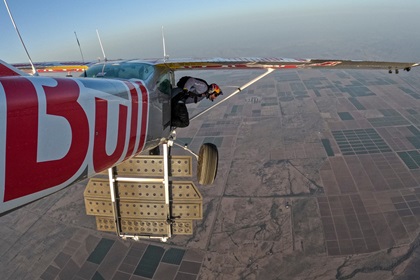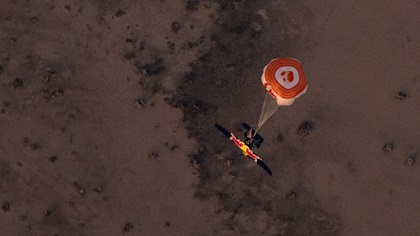FAA investigating Red Bull 'Plane Swap' attempt
Exemption request denied prior to livestream event

Both pilot-skydivers who participated in the made-for-streaming event were unhurt, and made brief statements after the attempt included in a short video released by Red Bull. Only one of the two Cessna 182s, both manufactured in the 1960s, completed its flight successfully. Pilot Luke Aikins was able to successfully jump out of the blue Cessna 182 he took off in, and into the silver Cessna 182 as planned. Pilot-skydiver Andy Farrington parachuted to safety after the blue Cessna 182 entered a spin and crashed in the Arizona desert. Red Bull reported in an email “the plane’s safety mechanisms activated, but the plane was damaged.” The edited video of the event released by Red Bull includes some of the key moments, though less than four minutes of the multi-hour broadcast was released. In that video, the parachute can be seen deploying from the blue Cessna in a vertical dive, but cuts to Farrington under his parachute canopy before the aircraft impacts the Arizona desert near Eloy.
Red Bull posted a detailed account, including additional videos and descriptions of how the "swap" was supposed to work ahead of the event.

“We're there, all the numbers matched up and everything like that," Farrington said in the video clip released by Red Bull of a post-flight interview. “Everything should have been good to go. For some reason, it wasn't that way, but at the end of the day, we're both here, we're both good to go, everybody's safe and sound, and I guess that's the important part.”
The event was advertised by Red Bull as a “world-first” and livestreamed on Hulu. The stunt involved putting the two Cessna 182s into a synchronized nosedive at 14,000 feet, with an airbrake deployed and autopilot set to maintain the dive. Both pilots then jumped out of their respective aircraft to attempt to reach the other aircraft in freefall. According to Red Bull, the aircraft required “a custom-built autopilot system to ensure they stay on the correct trajectory.” They were “fitted with a speed brake and larger than standard wheels to help create more drag and slow the rate of decent, as well as ensure the skydivers can catch up to them. The autopilot will activate once the pilots have manually entered the nosedive and switched the engines off to cause the planes to stall in mid-air.”
Both aircraft are registered to Para Tactics LLC in Washington state, and both have experimental airworthiness certificates, according to the FAA aircraft registration database.
A Denial of Exemption letter from the FAA dated April 22 and addressed to Aikins detailed why the FAA declined Aikins' request to be exempted from FAR 91.105(a): “The proposed exemption, if granted would authorize [both pilots] ... to depart the flight deck and attempt to swap aircraft in-flight while both aircraft are at vertical dive. During the swap, both aircraft will be unoccupied.”
The FAA noted in the denial letter that “granting an exemption from § 91.105(a) would not be in the public interest and [FAA] cannot find that the proposed operation would not adversely affect safety.”

The FAA further stated in the letter, "the petition fails to address compliance with any other applicable regulations in title 14 of the Code of Federal Regulations during the proposed operation, such as maintaining vigilance to see and avoid other aircraft in accordance with § 91.113. The FAA does not evaluate these deficiencies in greater detail because the petitioner does not provide a sufficient public interest case."
The FAA further determined that granting the requested exemption and allowing Aikins to attempt the "airplane swap" without a safety pilot on board each aircraft created unnecessary risk.
"The petitioner states that he has been conducting the operation in compliance with FAA regulations by having an additional pilot on board the airplane designated as PIC while the airplane swap described in the petition for exemption occurs. Because the FAA cannot conclude that the operations for which relief is sought (i.e., an operation without a pilot in the airplane and at the controls) would not adversely affect safety, and because the petitioner can continue to perform this demonstration in compliance with FAA regulations by including an additional pilot for each airplane, there is no public interest in granting the exemption request."
The NTSB is also investigating the incident, and a spokesperson said a preliminary report will likely be released "within the next few weeks."




